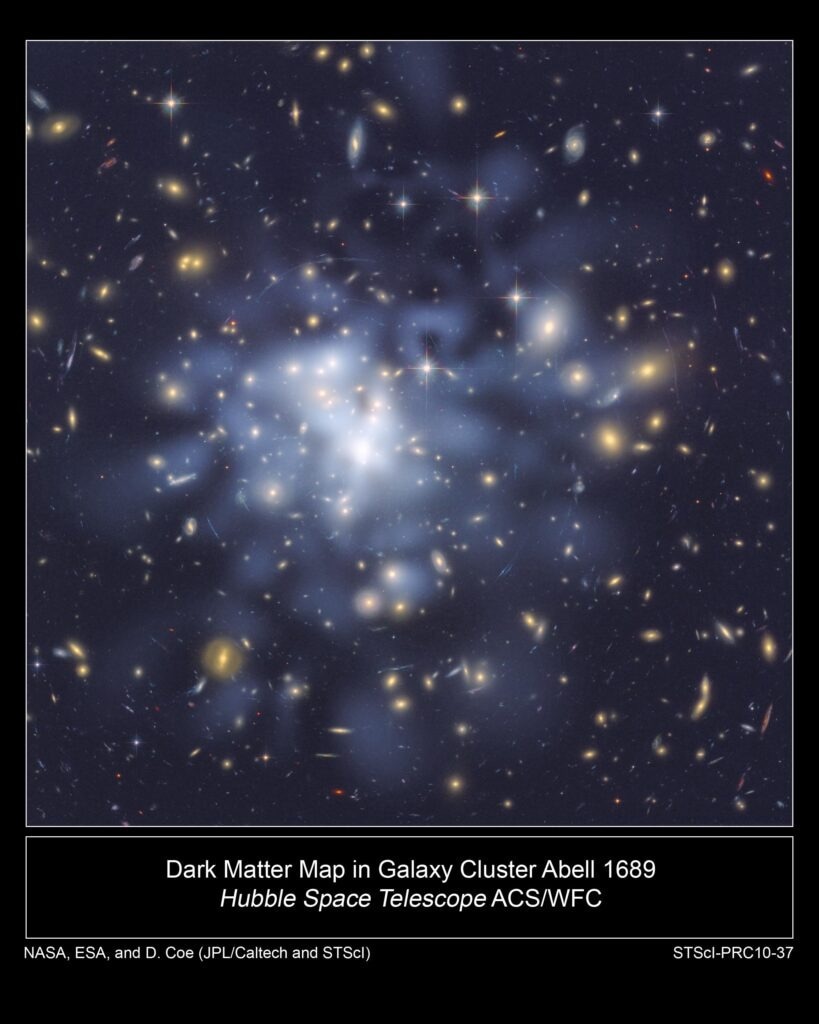As far as modern physics is concerned, dark matter is still one of the greatest mysteries. The existence of dark matter is certain, because without dark matter, for instance, it is not possible to explain the motion of galaxies. However, to date, the detection of dark matter in an experiment has not been possible.

This NASA Hubble Space Telescope image shows the distribution of dark matter in the center of the giant galaxy cluster Abell 1689, containing about 1,000 galaxies and trillions of stars. Dark matter is an invisible form of matter that accounts for most of the universe’s mass. Hubble cannot see the dark matter directly. Astronomers inferred its location by analyzing the effect of gravitational lensing, where light from galaxies behind Abell 1689 is distorted by intervening matter within the cluster. Researchers used the observed positions of 135 lensed images of 42 background galaxies to calculate the location and amount of dark matter in the cluster. They superimposed a map of these inferred dark matter concentrations, tinted blue, on an image of the cluster taken by Hubble’s Advanced Camera for Surveys. If the cluster’s gravity came only from the visible galaxies, the lensing distortions would be much weaker. The map reveals that the densest concentration of dark matter is in the cluster’s core. Abell 1689 resides 2.2 billion light-years from Earth. The image was taken in June 2002. Image Credit: NASA, ESA, D. Coe (NASA Jet Propulsion Laboratory/California Institute of Technology, and Space Telescope Science Institute), N. Benitez (Institute of Astrophysics of Andalusia, Spain), T. Broadhurst (University of the Basque Country, Spain), and H. Ford (Johns Hopkins University).
As far as modern physics is concerned, dark matter is still one of the greatest mysteries. The existence of dark matter is certain, because without dark matter, for instance, it is not possible to explain the motion of galaxies. However, to date, the detection of dark matter in an experiment has not been possible.
There are numerous proposals for new experiments. Now, physicists aim to detect dark matter directly through its scattering from the constituents of the atomic nuclei of a detection medium—that is, neutrons and protons.
A new candidate for dark matter called HYPER, or “HighlY Interactive ParticlE Relics” has been suggested by a research group including Robert McGehee and Aaron Pierce of the University of Michigan and Gilly Elor of Johannes Gutenberg University of Mainz in Germany.
As far as the HYPER model is concerned, sometime after the formation of dark matter in the early universe, the power of its interaction with normal matter suddenly increased. This makes it potentially detectable today and at the same time can explain the abundance of dark matter.
The New Diversity in the Dark Matter Sector
There has not been a consistent dark matter model for the mass range that some planned experiments hope to access. However, our HYPER model illustrates that a phase transition can actually help make the dark matter more easily detectable.
Gilly Elor, Postdoctoral Researcher, Theoretical Physics, Johannes Gutenberg University
The difficulty for an ideal model is that if the interaction of the dark matter is too powerful with normal matter, its (accurately known) amount formed in the early universe would be too small, thereby resulting in a contradiction to astrophysical observations.
However, if the production occurs in just the right amount, the interaction would be too weak for the detection of dark matter in present-day experiments.
McGehee stated, “Our central idea, which underlies the HYPER model, is that the interaction changes abruptly once—so we can have the best of both worlds: the right amount of dark matter and a large interaction so we might detect it.”
In particle physics, interaction is generally mediated by a particular particle. In the same way, the interaction of dark matter with normal matter is performed. The formation of dark matter and its detection work through the mediator, with the strength of the interaction based on its mass: The larger the mass, the weaker the interaction will be.
First of all, the mediator should be very heavy so that the right amount of dark matter is created, and subsequently very light so that dark matter is detectable. The solution was a phase transition following the detection of dark matter, during which an abrupt decrease in the mass of the mediator was found.
Pierce stated, “Thus, on the one hand, the amount of dark matter is kept constant, and on the other hand, the interaction is boosted or strengthened in such a way that dark matter should be directly detectable.”
New Model Covers Almost the Full Parameter Range of Planned Experiments
The HYPER model of dark matter is able to cover almost the entire range that the new experiments make accessible.
Gilly Elor, Postdoctoral Researcher, Theoretical Physics, Johannes Gutenberg University
Particularly, the research group initially considered the maximum cross-section of the mediator-mediated interaction with the neutrons and protons of an atomic nucleus. This was done to be consistent with some particle-physics decays and astrological observations. The next step was to examine if there was a model available for dark matter displaying this interaction.
McGehee stated, “And here we came up with the idea of the phase transition. We then calculated the amount of dark matter that exists in the universe and then simulated the phase transition using our calculations.”
There are several constraints to be kept in mind, like a constant amount of dark matter:
Here, we have to systematically consider and include very many scenarios, for example, asking the question whether it is really certain that our mediator does not suddenly lead to the formation of new dark matter, which of course must not be. But in the end, we were convinced that our HYPER model works.
Gilly Elor, Postdoctoral Researcher, Theoretical Physics, Johannes Gutenberg University
Journal Reference:
Elor, G., et al. (2023) Maximizing Direct Detection with Highly Interactive Particle Relic Dark Matter. Physical Review Letters. doi.org/10.1103/PhysRevLett.130.031803